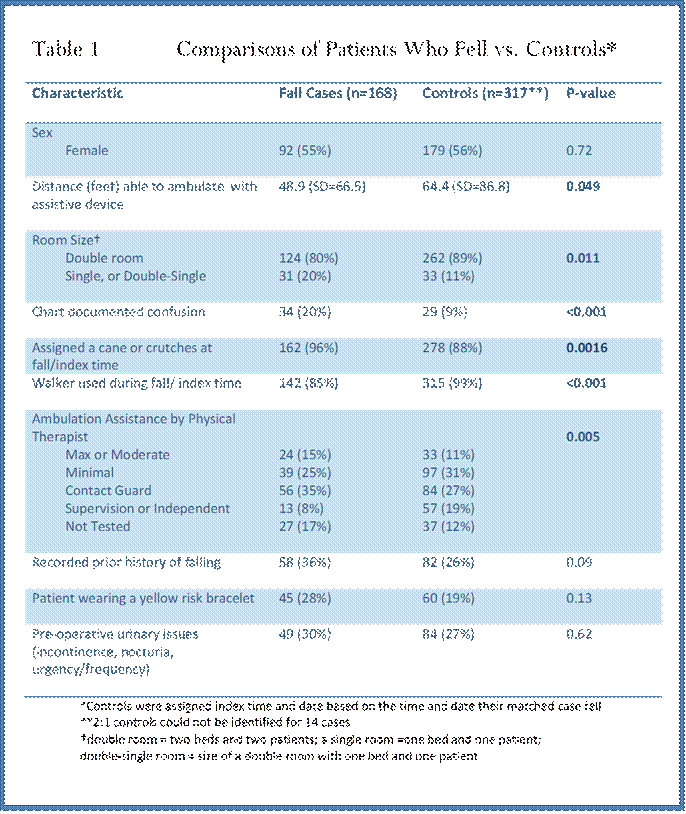Session Information
Title: Health Services Research, Quality Measures and Quality of Care - Innovations in Health Care Delivery
Session Type: Abstract Submissions (ACR)
Background/Purpose:
This study evaluated rates and predictors of falls among adult orthopedic in-patients at a musculoskeletal specialty hospital.
Methods:
Researchers prospectively studied falls from 5/2/10-5/1/12. Two controls were matched to every fall on age, post-operative day (POD), type of orthopedic procedure, and each assigned the index time that their case fell. Data were collected via chart review and patient questionnaire. Medical record data for controls was abstracted from last note prior to the index time or first note after. Differences between cases and controls were compared using t-test or chi-square test, as appropriate. A multivariate logistic regression was performed to identify predictors of falls.
Results:
There were 169 falls during the study timeframe. The fall rate was 0.65 of in-patient orthopedic admissions; 1.67 falls/1000 in-patient days. The average age of cases was 68.4 yrs, (SD 12.7), 55% were women, mean BMI was 29.4, (SD 6.5), and average POD was 2.9 (SD 2.5). One patient fell twice. 39.5% of falls occurred in total knee replacements (TKR), 23.3% in total hip replacements (THR), 25.8% in spine procedures, 9.6% in lower extremity procedures and 1.8% in upper extremity procedures. 92% of falls occurred in the patients’ room. Neither a known history of falls nor wearing a “falls risk” bracelet was associated with falling. Fallers were less likely to use a crutch or cane, more likely to use a walker, and more likely to be in a single occupancy room. Cases walked significantly fewer feet and required significantly more physical therapy (PT) ambulation assistance than controls. 31% of falls involved using the bathroom. Of 168 first falls, 28 (17%) resulted in injuries, most of which were minor. 8 falls (4.8%) resulted in 10 serious adverse events (AEs), including 4 dehiscence/return OR, 3 transfer to a higher level of care, 2 dislocations and 1 fracture. There we no deaths or intracranial/epidural bleeds.
In a logistic regression controlling for significant univariate predictors (single room occupancy, confusion, being assigned canes/crutches, using a walker or needing physical therapy assistance to ambulate) the only predictors of falls were confusion (OR 2.6; 95% CI 1.4-4.8) and using a walker (OR 28.6; 95% CI 6.5-125.0). Being in a double occupancy room was borderline protective against falling (OR 0.55; 95% CI 0.3-1.003). Among TKR, having a femoral block trended towards being associated with falls (p-value=0.057). There were no significant predictors of AEs.
Conclusion:
The rate of falls and AEs in this patient population was low. This large series identifies confusion and using a walker as being predictive of falling among orthopedic in-patients. Larger studies are needed to confirm these results, and to inform fall prevention strategies in this rapidly growing group of patients.
Disclosure:
L. A. Mandl,
Boehringer Ingelheim,
2;
W. T. Huang,
None;
J. Lee,
None;
T. Bailey,
None;
D. Edwards,
None;
P. Quinlan,
None;
M. Sasaki,
None;
S. K. Magid,
None.
« Back to 2013 ACR/ARHP Annual Meeting
ACR Meeting Abstracts - https://acrabstracts.org/abstract/falls-among-hospitalized-orthopedic-patients-a-prospective-case-control-study/

